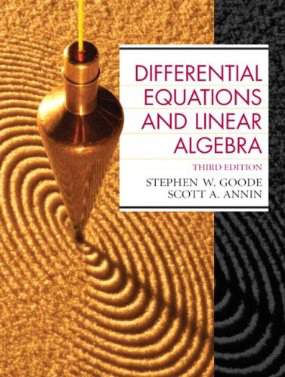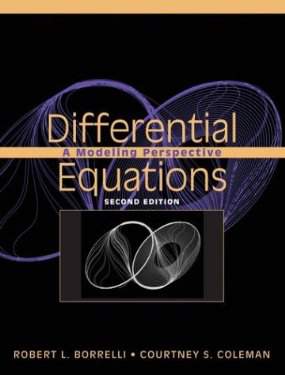

Professor Murray
Solution of the Heat Equation
Slide Duration:Table of Contents
Section 1: First-Order Equations
Linear Equations
1h 7m 21s
- Intro0:00
- Lesson Objectives0:19
- How to Solve Linear Equations2:54
- Calculate the Integrating Factor2:58
- Changes the Left Side so We Can Integrate Both Sides3:27
- Solving Linear Equations5:32
- Further Notes6:10
- If P(x) is Negative6:26
- Leave Off the Constant9:38
- The C Is Important When Integrating Both Sides of the Equation9:55
- Example 110:29
- Example 222:56
- Example 336:12
- Example 439:24
- Example 544:10
- Example 656:42
Separable Equations
35m 11s
- Intro0:00
- Lesson Objectives0:19
- Some Equations Are Both Linear and Separable So You Can Use Either Technique to Solve Them1:33
- Important to Add C When You Do the Integration2:27
- Example 14:28
- Example 210:45
- Example 314:43
- Example 419:21
- Example 527:23
Slope & Direction Fields
1h 11m 36s
- Intro0:00
- Lesson Objectives0:20
- If You Can Manipulate a Differential Equation Into a Certain Form, You Can Draw a Slope Field Also Known as a Direction Field0:23
- How You Do This0:45
- Solution Trajectories2:49
- Never Cross Each Other3:44
- General Solution to the Differential Equation4:03
- Use an Initial Condition to Find Which Solution Trajectory You Want4:59
- Example 16:52
- Example 214:20
- Example 326:36
- Example 434:21
- Example 546:09
- Example 659:51
Applications, Modeling, & Word Problems of First-Order Equations
1h 5m 19s
- Intro0:00
- Lesson Overview0:38
- Mixing1:00
- Population2:49
- Finance3:22
- Set Variables4:39
- Write Differential Equation6:29
- Solve It10:54
- Answer Questions11:47
- Example 113:29
- Example 224:53
- Example 332:13
- Example 442:46
- Example 555:05
Autonomous Equations & Phase Plane Analysis
1h 1m 20s
- Intro0:00
- Lesson Overview0:18
- Autonomous Differential Equations Have the Form y' = f(x)0:21
- Phase Plane Analysis0:48
- y' < 02:56
- y' > 03:04
- If we Perturb the Equilibrium Solutions5:51
- Equilibrium Solutions7:44
- Solutions Will Return to Stable Equilibria8:06
- Solutions Will Tend Away From Unstable Equilibria9:32
- Semistable Equilibria10:59
- Example 111:43
- Example 215:50
- Example 328:27
- Example 431:35
- Example 543:03
- Example 649:01
Section 2: Second-Order Equations
Distinct Roots of Second Order Equations
28m 44s
- Intro0:00
- Lesson Overview0:36
- Linear Means0:50
- Second-Order1:15
- Homogeneous1:30
- Constant Coefficient1:55
- Solve the Characteristic Equation2:33
- Roots r1 and r23:43
- To Find c1 and c2, Use Initial Conditions4:50
- Example 15:46
- Example 28:20
- Example 316:20
- Example 418:26
- Example 523:52
Complex Roots of Second Order Equations
31m 49s
- Intro0:00
- Lesson Overview0:15
- Sometimes The Characteristic Equation Has Complex Roots1:12
- Example 13:21
- Example 27:42
- Example 315:25
- Example 418:59
- Example 527:52
Repeated Roots & Reduction of Order
43m 2s
- Intro0:00
- Lesson Overview0:23
- If the Characteristic Equation Has a Double Root1:46
- Reduction of Order3:10
- Example 17:23
- Example 29:20
- Example 314:12
- Example 431:49
- Example 533:21
Undetermined Coefficients of Inhomogeneous Equations
50m 1s
- Intro0:00
- Lesson Overview0:11
- Inhomogeneous Equation Means the Right Hand Side is Not 0 Anymore0:21
- First Solve the Homogeneous Equation1:04
- Find a Particular Solution to the Inhomogeneous Equation Using Undetermined Coefficients2:03
- g(t) vs. Guess for ypar2:42
- If Any Term of Your Guess for ypar Looks Like Any Term of yhom5:07
- Example 17:54
- Example 215:25
- Example 323:45
- Example 433:35
- Example 542:57
Inhomogeneous Equations: Variation of Parameters
49m 22s
- Intro0:00
- Lesson Overview0:31
- Inhomogeneous vs. Homogeneous0:47
- First Solve the Homogeneous Equation1:17
- Notice There is No Coefficient in Front of y''1:27
- Find a Particular Solution to the Inhomogeneous Equation Using Variation of Parameters2:32
- How to Solve4:33
- Hint on Solving the System5:23
- Example 17:27
- Example 217:46
- Example 323:14
- Example 431:49
- Example 536:00
Section 3: Series Solutions
Review of Power Series
57m 38s
- Intro0:00
- Lesson Overview0:36
- Taylor Series Expansion0:37
- Maclaurin Series2:36
- Common Maclaurin Series to Remember From Calculus3:35
- Radius of Convergence7:58
- Ratio Test12:05
- Example 115:18
- Example 220:02
- Example 327:32
- Example 439:33
- Example 545:42
Series Solutions Near an Ordinary Point
1h 20m 28s
- Intro0:00
- Lesson Overview0:49
- Guess a Power Series Solution and Calculate Its Derivatives, Example 11:03
- Guess a Power Series Solution and Calculate Its Derivatives, Example 23:14
- Combine the Series5:00
- Match Exponents on x By Shifting Indices5:11
- Match Starting Indices By Pulling Out Initial Terms5:51
- Find a Recurrence Relation on the Coefficients7:09
- Example 17:46
- Example 219:10
- Example 329:57
- Example 441:46
- Example 557:23
- Example 61:09:12
Euler Equations
24m 42s
- Intro0:00
- Lesson Overview0:11
- Euler Equation0:15
- Real, Distinct Roots2:22
- Real, Repeated Roots2:37
- Complex Roots2:49
- Example 13:51
- Example 26:20
- Example 38:27
- Example 413:04
- Example 515:31
- Example 618:31
Series Solutions
1h 26m 17s
- Intro0:00
- Lesson Overview0:13
- Singular Point1:17
- Definition: Pole of Order n1:58
- Pole Of Order n2:04
- Regular Singular Point3:25
- Solving Around Regular Singular Points7:08
- Indical Equation7:30
- If the Difference Between the Roots is An Integer8:06
- If the Difference Between the Roots is Not An Integer8:29
- Example 18:47
- Example 214:57
- Example 325:40
- Example 447:23
- Example 51:09:01
Section 4: Laplace Transform
Laplace Transforms
41m 52s
- Intro0:00
- Lesson Overview0:09
- Laplace Transform of a Function f(t)0:18
- Laplace Transform is Linear1:04
- Example 11:43
- Example 218:30
- Example 322:06
- Example 428:27
- Example 533:54
Inverse Laplace Transforms
47m 5s
- Intro0:00
- Lesson Overview0:09
- Laplace Transform L{f}0:13
- Run Partial Fractions0:24
- Common Laplace Transforms1:20
- Example 13:24
- Example 29:55
- Example 314:49
- Example 422:03
- Example 533:51
Laplace Transform Initial Value Problems
45m 15s
- Intro0:00
- Lesson Overview0:12
- Start With Initial Value Problem0:14
- Take the Laplace Transform of Both Sides of the Differential Equation0:37
- Plug in the Identities1:20
- Take the Inverse Laplace Transform to Find y2:40
- Example 14:15
- Example 211:30
- Example 317:59
- Example 424:51
- Example 536:05
Section 5: Review of Linear Algebra
Review of Linear Algebra
57m 30s
- Intro0:00
- Lesson Overview0:41
- Matrix0:54
- Determinants4:45
- 3x3 Determinants5:08
- Eigenvalues and Eigenvectors7:01
- Eigenvector7:48
- Eigenvalue7:54
- Lesson Overview8:17
- Characteristic Polynomial8:47
- Find Corresponding Eigenvector9:03
- Example 110:19
- Example 216:49
- Example 320:52
- Example 425:34
- Example 535:05
Section 6: Systems of Equations
Distinct Real Eigenvalues
59m 26s
- Intro0:00
- Lesson Overview1:11
- How to Solve Systems2:48
- Find the Eigenvalues and Their Corresponding Eigenvectors2:50
- General Solution4:30
- Use Initial Conditions to Find c1 and c24:57
- Graphing the Solutions5:20
- Solution Trajectories Tend Towards 0 or ∞ Depending on Whether r1 or r2 are Positive or Negative6:35
- Solution Trajectories Tend Towards the Axis Spanned by the Eigenvector Corresponding to the Larger Eigenvalue7:27
- Example 19:05
- Example 221:06
- Example 326:38
- Example 436:40
- Example 543:26
- Example 651:33
Complex Eigenvalues
1h 3m 54s
- Intro0:00
- Lesson Overview0:47
- Recall That to Solve the System of Linear Differential Equations, We find the Eigenvalues and Eigenvectors0:52
- If the Eigenvalues are Complex, Then They Will Occur in Conjugate Pairs1:13
- Expanding Complex Solutions2:55
- Euler's Formula2:56
- Multiply This Into the Eigenvector, and Separate Into Real and Imaginary Parts1:18
- Graphing Solutions From Complex Eigenvalues5:34
- Example 19:03
- Example 220:48
- Example 328:34
- Example 441:28
- Example 551:21
Repeated Eigenvalues
45m 17s
- Intro0:00
- Lesson Overview0:44
- If the Characteristic Equation Has a Repeated Root, Then We First Find the Corresponding Eigenvector1:14
- Find the Generalized Eigenvector1:25
- Solutions from Repeated Eigenvalues2:22
- Form the Two Principal Solutions and the Two General Solution2:23
- Use Initial Conditions to Solve for c1 and c23:41
- Graphing the Solutions3:53
- Example 18:10
- Example 216:24
- Example 323:25
- Example 431:04
- Example 538:17
Section 7: Inhomogeneous Systems
Undetermined Coefficients for Inhomogeneous Systems
43m 37s
- Intro0:00
- Lesson Overview0:35
- First Solve the Corresponding Homogeneous System x'=Ax0:37
- Solving the Inhomogeneous System2:32
- Look for a Single Particular Solution xpar to the Inhomogeneous System2:36
- Plug the Guess Into the System and Solve for the Coefficients3:27
- Add the Homogeneous Solution and the Particular Solution to Get the General Solution3:52
- Example 14:49
- Example 29:30
- Example 315:54
- Example 420:39
- Example 529:43
- Example 637:41
Variation of Parameters for Inhomogeneous Systems
1h 8m 12s
- Intro0:00
- Lesson Overview0:37
- Find Two Solutions to the Homogeneous System2:04
- Look for a Single Particular Solution xpar to the inhomogeneous system as follows2:59
- Solutions by Variation of Parameters3:35
- General Solution and Matrix Inversion6:35
- General Solution6:41
- Hint for Finding Ψ-16:58
- Example 18:13
- Example 216:23
- Example 332:23
- Example 437:34
- Example 549:00
Section 8: Numerical Techniques
Euler's Method
45m 30s
- Intro0:00
- Lesson Overview0:32
- Euler's Method is a Way to Find Numerical Approximations for Initial Value Problems That We Cannot Solve Analytically0:34
- Based on Drawing Lines Along Slopes in a Direction Field1:18
- Formulas for Euler's Method1:57
- Example 14:47
- Example 214:45
- Example 324:03
- Example 433:01
- Example 537:55
Runge-Kutta & The Improved Euler Method
41m 4s
- Intro0:00
- Lesson Overview0:43
- Runge-Kutta is Know as the Improved Euler Method0:46
- More Sophisticated Than Euler's Method1:09
- It is the Fundamental Algorithm Used in Most Professional Software to Solve Differential Equations1:16
- Order 2 Runge-Kutta Algorithm1:45
- Runge-Kutta Order 2 Algorithm2:09
- Example 14:57
- Example 210:57
- Example 319:45
- Example 424:35
- Example 531:39
Section 9: Partial Differential Equations
Review of Partial Derivatives
38m 22s
- Intro0:00
- Lesson Overview1:04
- Partial Derivative of u with respect to x1:37
- Geometrically, ux Represents the Slope As You Walk in the x-direction on the Surface2:47
- Computing Partial Derivatives3:46
- Algebraically, to Find ux You Treat The Other Variable t as a Constant and Take the Derivative with Respect to x3:49
- Second Partial Derivatives4:16
- Clairaut's Theorem Says that the Two 'Mixed Partials' Are Always Equal5:21
- Example 15:34
- Example 27:40
- Example 311:17
- Example 414:23
- Example 531:55
The Heat Equation
44m 40s
- Intro0:00
- Lesson Overview0:28
- Partial Differential Equation0:33
- Most Common Ones1:17
- Boundary Value Problem1:41
- Common Partial Differential Equations3:41
- Heat Equation4:04
- Wave Equation5:44
- Laplace's Equation7:50
- Example 18:35
- Example 214:21
- Example 321:04
- Example 425:54
- Example 535:12
Separation of Variables
57m 44s
- Intro0:00
- Lesson Overview0:26
- Separation of Variables is a Technique for Solving Some Partial Differential Equations0:29
- Separation of Variables2:35
- Try to Separate the Variables2:38
- If You Can, Then Both Sides Must Be Constant2:52
- Reorganize These Intro Two Ordinary Differential Equations3:05
- Example 14:41
- Example 211:06
- Example 318:30
- Example 425:49
- Example 532:53
Fourier Series
1h 24m 33s
- Intro0:00
- Lesson Overview0:38
- Fourier Series0:42
- Find the Fourier Coefficients by the Formulas2:05
- Notes on Fourier Series3:34
- Formula Simplifies3:35
- Function Must be Periodic4:23
- Even and Odd Functions5:37
- Definition5:45
- Examples6:03
- Even and Odd Functions and Fourier Series9:47
- If f is Even9:52
- If f is Odd11:29
- Extending Functions12:46
- If We Want a Cosine Series14:13
- If We Wants a Sine Series15:20
- Example 117:39
- Example 243:23
- Example 351:14
- Example 41:01:52
- Example 51:11:53
Solution of the Heat Equation
47m 41s
- Intro0:00
- Lesson Overview0:22
- Solving the Heat Equation1:03
- Procedure for the Heat Equation3:29
- Extend So That its Fourier Series Will Have Only Sines3:57
- Find the Fourier Series for f(x)4:19
- Example 15:21
- Example 28:08
- Example 317:42
- Example 425:13
- Example 528:53
- Example 642:22
Loading...
This is a quick preview of the lesson. For full access, please Log In or Sign up.
For more information, please see full course syllabus of Differential Equations
For more information, please see full course syllabus of Differential Equations
Differential Equations Solution of the Heat Equation
Lecture Description
In this lesson, our instructor Will Murray gives an introduction on solution of the heat equation. He discusses the partial differential equation and how to solve it, as well as the procedure for the heat equation.
Bookmark & Share
Embed
Share this knowledge with your friends!
Copy & Paste this embed code into your website’s HTML
Please ensure that your website editor is in text mode when you paste the code.(In Wordpress, the mode button is on the top right corner.)
×
Since this lesson is not free, only the preview will appear on your website.
- - Allow users to view the embedded video in full-size.
Next Lecture
Previous Lecture










































 Answer Engine
Answer Engine






1 answer
Mon May 28, 2018 11:03 AM
Post by Adam Prieto on May 26, 2018
Dear Dr. Murray,
I have just finished all of your lectures in the Differential Equations course here on Educator and loved every minute of it. In addition to taking the time to explain these difficult topics in a way that students can easily understand, you did a great job of showing us how the Calculus and Linear Algebra courses we took previously really comes in handy when studying Differential Equations; the course was fantastic! I especially liked how you gave us a taste of what’s to be offered down the road in Partial Differential Equations with this last unit. Out of curiosity, have you considered making a Partial Differential Equations course here on Educator.com? I’m sure it’d be a great follow up to Ordinary Differential Equations as well as give us an excuse to come back and continue our mathematical career with you as our online lecturer. Either way, I’d personally like to thank you for helping me through this course as well helping me earn an “A” in my Differential Equations course at my university.
Respectfully,
Adam P.
1 answer
Mon Jan 11, 2016 6:27 PM
Post by Joseph Szmulewicz on January 9, 2016
Dear Dr. Murray,
I have watched both the probability and differential equations courses and they are both great! You explained the concepts very well. Question. Do you have any plans to create a new course for Educator.com in the future? If so, I would like to make a suggestion. Math for quantum mechanics. thanks
regards,
Joe
3 answers
Mon Aug 17, 2015 10:10 AM
Post by Muhammad Asad Ullah MOAVIA on August 13, 2015
Dear Professor William Murry,
Thank you so much for providing an amazing mathematics courses. I was very weak in differential equation and in probability and I have solved all my problems through your courses. I will always remember you in my prayers! Dear Professor, I have one question to you. If you provide a real analysis course through educator.com, it would be very nice of you. As I know you are connoisseur in the field of mathematics, at least you would guide me in real analysis course. As for me, I am doing my M.Phil in economic policy. I am keen to learn the game theory, so for game theory is concerned, it is all about real analysis and optimization. I am good in optimization, but very poor in real analysis. I am looking forward to hear from you soon.
Cordially,
Assad
Turkey
1 answer
Wed May 6, 2015 8:54 PM
Post by Alexander Guevara on May 4, 2015
HI Dr. Murray, do you have tutorial on Sturm Liouville?
1 answer
Sun Jan 4, 2015 7:41 PM
Post by John Nash on December 31, 2014
Happy New Year Sir,
You have been of great help for my differential equations course I have taken this semester.
1 answer
Mon Dec 15, 2014 1:19 PM
Post by suzanne El Shafei on December 12, 2014
Hi there,
I have a question I am trying to solve but my initial conditions are f(x)=100x 0<x<2
=100(4-x) 2<x<4
How would you suggest i set this up for the integration can i have an integral over 100x only?
1 answer
Tue Dec 10, 2013 11:47 PM
Post by Edward Arreguin on December 9, 2013
Can you make videos on the solution for the insulated rod and the steady state solution?
1 answer
Wed Nov 20, 2013 9:55 AM
Post by Satendra Guru on November 12, 2013
I am confussed when you arrive at the 2n+1 for odd numbers? Can you explain this better.
Thanks,